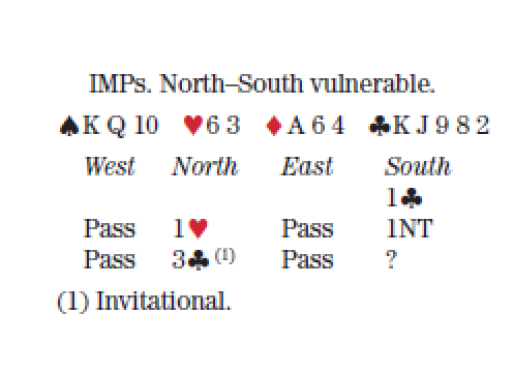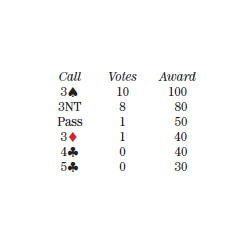
What’s your call?
| 3♦ | 3♥ | 3♠ | 3NT | |
| 4♣ | 4♦ | 4♥ | 4♠ | 4NT |
| 5♣ | 5♦ | 5♥ | 5♠ | 5NT |
| 6♣ | 6♦ | 6♥ | 6♠ | 6NT |
| 7♣ | 7♦ | 7♥ | 7♠ | 7NT |
| Dbl | Pass |
Except for Colchamiro, the lone passer, the panelists are inclined to move forward once partner has shown a club fit. The favored mode of transportation is 3♠, which carries multiple meanings.
Falk says that while it’s tempting to pass, “it is IMPs and we are vulnerable. I don’t want to just bid 3NT. Partner would have to pass with:
♠J x x ♥A x x x ♦x ♣A x x x x,
when 5♣ is essentially cold and 3NT has no play. So, as usual, I’m trying for science. I expect my partners to be able to make intelligent contributions to the discourse.”
The Joyces “can’t” pass. “Let’s see if partner has a diamond card.”
Cohen bids ♠ and says, “This might be too delicate (as opposed to bashing). But surely we belong in 5♣ (not 3NT) opposite, say,
♠A x x ♥A x x x ♦x ♣Q 10 x x x
and partner will know it.”
Boehm bids 3♠ to “show a maximum with a spade concentration and keeps clubs and notrump in play.”
“Could be a great fitter for 5♣ if partner has short diamonds,” says Sanborn. “If he has short spades, I probably want to play 3NT. So 3♠ is telling where I live.”
“3♠ allows partner to bid 3NT from his side of the table,” reasons Kennedy.
“3♠ to give it one more try — we’re not quite ready to commit to 3NT,” say the Gordons. “If partner bids 4♣, we give up.”
“3♠ shows a concentration of values and doubt about the other suit,” says Walker. “Partner almost always has a singleton for this auction (or he would have raised to 2NT with a semi-balanced hand). If he’s short in spades and has a diamond stopper, he’ll bid 3NT. If he’s short in diamonds, he’ll bid 4♣ or 5♣.”
Rigal, too: “If 3♣ is invitational (not exactly standard these days — it’s normally played as weak or game-forcing), then 3♠ suggests my values and helps partner decide whether to go to game or play 4♣. I won’t pass 4♣ though. With such crisp values, I can make game facing very little — for instance:
♠A x x ♥A x x x ♦x ♣Q x x x x.”
Several panelists think 3NT is a fine bid.
“IMPs and vulnerable, almost automatic, also ready for the expected spade lead,” say the Sutherlins.
“The fifth club and the ♠10 are important cards in the auction. Hopefully enough to make a vulnerable game,” explains Giragosian.
“It is IMPs, we are vulnerable and we are max with a good club suit and solid stoppers in the unbid suits,” says Stack, “so 3NT seems standout.”
“I’m not passing,” insists Weinstein. “I have a max and a five-card suit opposite known support. 3♠ might be the ‘correct’ bid in case partner has short diamonds, but I don’t think it’s the winningest bid.”
“I have a maximum hand with tricks, so I bid 3NT,” agrees Lawrence. “I can’t tell that diamonds is a weak spot and if I bid 3♠, it gives away information.”
The Coopers explore further by bidding 3♦. “If partner has two black bullets and a heart stop, we can make 3NT. If partner has nothing in hearts, then 5♣ is a real possibility.”
Colchamiro suggests that had partner bid 2NT, “a simple quantitative question,” he would have bid 3NT with his solid hand and fifth club. “But here, partner has shown shape, but probably not 5♥ (or he would have bid 2♦). Opposite a hand like:
♠x x ♥K J x x ♦x x ♣A Q x x x,
with only one diamond stopper or no heart stopper, 3NT seems far, far away.” So he passes.

